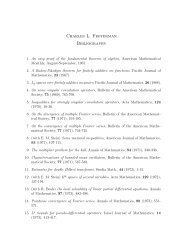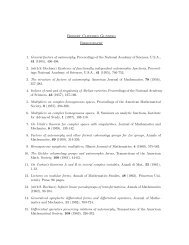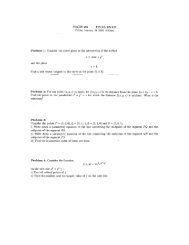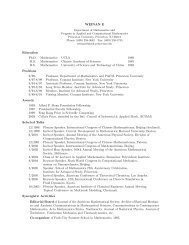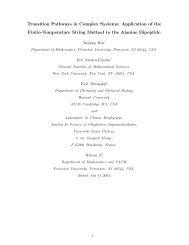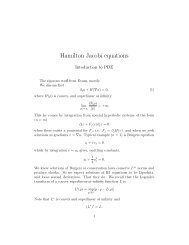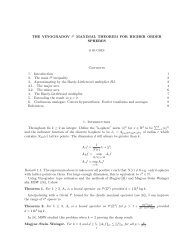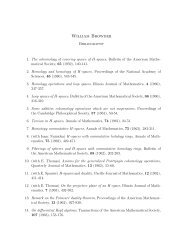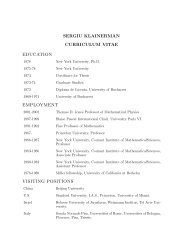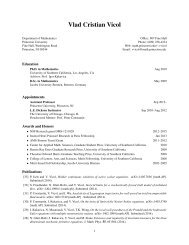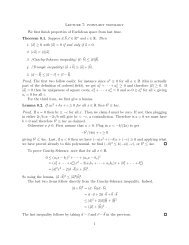The rational Khovanov homology of 3-strand pretzel links
The rational Khovanov homology of 3-strand pretzel links
The rational Khovanov homology of 3-strand pretzel links
Create successful ePaper yourself
Turn your PDF publications into a flip-book with our unique Google optimized e-Paper software.
THE RATIONAL KHOVANOV HOMOLOGY OF 3-STRAND PRETZEL LINKS 31<br />
5.3. P(−l,m,n) for even l.<br />
<strong>The</strong>orem 5.3. When l is even, Kh(P(−l,m,n) RL ) is given by the formula in <strong>The</strong>orem<br />
2.9.<br />
Pro<strong>of</strong>. We already did the case <strong>of</strong> m = l, so we can induct on m ≥ l + 1. <strong>The</strong> base case<br />
m = l + 1 was also done above. Assume that our formula holds for P(−l,m − 1,n);<br />
we will prove it for P(−l,m,n) using the skein exact sequence for the top crossing in<br />
the middle <strong>strand</strong> (a positive crossing). <strong>The</strong> diagram for P(−l,m,n) has no negative<br />
crossings. <strong>The</strong> unoriented resolution is a diagram for the right-handed torus link T n−l,2 .<br />
If n is odd, the unoriented resolution diagram has l + m − 1 negative crossings, and<br />
T n−l,2 is a knot. If n is even, T n−l,2 is a 2-component link; orient it positively, so that<br />
the unoriented resolution diagram has l + m − 1 negative crossings. <strong>The</strong> sequence is<br />
f<br />
q 3l+3m−1 t l+m Kh(T n−l,2 ) Kh(P(−l,m,n)) qKh(P(−l,m − 1,n))<br />
where T n−l,2 is positively oriented when n is even. Call the three terms W, X, and V<br />
as usual, and write V = L ⊕ U. As before, L and U are based at the correct points to<br />
become the upper and lower summands in our desired formula for X, after cancellations.<br />
In fact, if m is even, there are no cancellations. To show this fact, first suppose<br />
m > l + 2. Nothing in W can cancel with anything in L for t-grading reasons, so<br />
X = L ⊕ X ′ where X ′ is a cancellation <strong>of</strong> U ⊕ W.<br />
Now, U has no exceptional pairs if n is odd, while if n is even, U has an exceptional<br />
pair in l+n. If n is odd, W has one exceptional pair in t = l+m, and if n is even it has an<br />
additional one in t = m + n. In either case, however, X ′ must have an exceptional pair<br />
everywhere that U or W does. Hence E X ′ ≥ E U +E W , so by Lemma 3.6, X ′ = U ⊕W.<br />
We are now done, since adding W to the upper summand U <strong>of</strong> V produces the upper<br />
summand we want for X.<br />
<strong>The</strong> remaining case for even m is m = l + 2. <strong>The</strong> same argument applies as soon as<br />
we can show that nothing in W cancels with anything in L. But any such cancellation<br />
would need to occur between t = 2l + 1 and t = 2l + 2. In the column t = 2l + 1, L has<br />
a single generator, which is part <strong>of</strong> a knight’s move. It cannot cancel because, if it did,<br />
its knight’s move partner could not be part <strong>of</strong> any knight’s move or exceptional pair in<br />
X. So we are done with even m.<br />
If m is odd, a few cancellations occur. We may again consider cancellations X ′ <strong>of</strong><br />
U ⊕ W. If n is odd, W has one exceptional pair in its lowest t-grading, t = l + m. V<br />
has an exceptional pair in t = l + m − 1 and X does not, so by Lemma 3.8, there must<br />
be a standard cancellation between t-gradings l + m − 1 and l + m.<br />
Now, any further cancellations would be cancellations <strong>of</strong> U ′ ⊕ W ′ as in Remark 3.7,<br />
but U ′ and W ′ have no exceptional pairs and are contained in δ = n + m − 1 and<br />
δ = n + m − 3, so Lemma 3.6 precludes any cancellations.<br />
If n is even (but m is still odd), the same analysis applies to the lower exceptional pair<br />
<strong>of</strong> W. Now, however, W has an additional exceptional pair in t = (n − l) + (l + m) =<br />
f<br />
,




